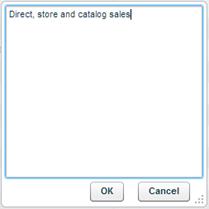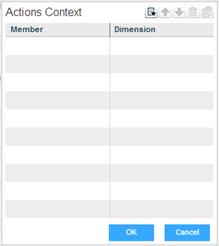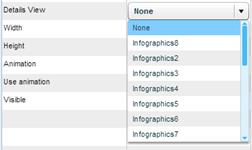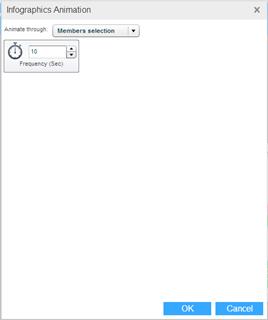
The infographics entity properties contain definitions that apply at the entity level: the entity’s caption, the tooltip displayed to the end-user, the background color, the animation style, the actions that can be executed from an entity, and more.
From the dropdown list at the top of the Properties Pane, select the entity level in order to display its properties.

For properties that include the Data Link ![]() icon, you can define a rule to control that property and connect it to the actual data. For example, if a value is larger than n, return the color red. After defining a data link, the icon changes to
icon, you can define a rule to control that property and connect it to the actual data. For example, if a value is larger than n, return the color red. After defining a data link, the icon changes to ![]() and a tooltip shows the details.
and a tooltip shows the details.
This is the ID of the entity. It is automatically assigned to the entity and cannot be changed.
The display name that will appear in the Infographics Entities pane.
This is the tooltip that appears when hovering over the infographics in the repository.
Click on the value column and then click the down arrow. Enter the tooltip text in the edit box. Click OK.

You can use the Data Link ![]() option to define a rule or a custom formula to display a tooltip text.
option to define a rule or a custom formula to display a tooltip text.
The tooltip will look like this:

This is the tooltip that appears when the end-user hovers over the infographics on the workboard.
Click on the value column and then click the down arrow. Enter the tooltip text in the edit box. Click OK.

On the workboard, the tooltip will look like this:

Click to open the palette and choose a color for the entity’s background. Or, use the Data Link ![]() option.
option.
Set to Yes in order to ignore the background color setting.
This property is used to define actions to be executed from the toolbar of this infographics entity in an Infographics Component in a workboard. The actions will be available for execution by clicking the Actions ![]() button.
button.

To define actions:
1. Click on Actions List and then click the down arrow.

2. Click the Create ![]() button and click on the value column. From the dropdown list, select an action.
button and click on the value column. From the dropdown list, select an action.

Move to another workboard
Clicking on the action will move the user to the workboard defined in this property.
Choose Move to another workboard, and in Select a Workboard choose the workboard to navigate to.
Click OK.
Open a browser window
Clicking on the action will open the specified web page in a browser window.
Choose Open a browser window, and in Enter page URL type in the page address.

Click OK.
Execute a JavaScript expression
Clicking on the action will execute the entered JavaScript code.
Choose Execute a JavaScript expression.

Click the arrow in Enter JavaScript expression and type in the code.

Click OK.
3. In Caption, the action’s caption appears automatically. This caption appears in the action’s tooltip. Click on it to edit it.
4. Click OK.
If the “Move to another workboard” action is defined in the Actions property, when the end-user will perform this action to move to another workboard, the current slicing in the workboard will apply to the other workboard. If you want the action to ignore the original slicing and move only certain dimension members, use the Actions Context property to define those members.
Click on Actions Context and click the down arrow.

Click on the Member column and then on the down arrow. Select a dimension member.

Repeat this for more dimension members. Click OK.
This property enables you to connect the entity to another entity in the infographics family. The Detailed View button appears on the entity’s toolbar in the infographics component and the end-user can click it to display the connected entity.

In the Details View property, select the entity.

The width and the height of the infographics entity.
This property is used to generate animation at the infographics entity level, which will occur when member selection is performed in the workboard.
Click on the value column and then click ![]() to open the Infographics Animation window.
to open the Infographics Animation window.

In Animate Through, select:
· Member Selection: The entity will be sliced according to the selected members, and animation will occur through the slicing.
· Members Expression: Define an MDX statement that returns a list of members. Animation will occur through these members.
Set the Frequency in seconds.
Click OK.
Set to Yes to enable the defined animation.
When set to Yes, the entity is visible to the end-user, for selection.